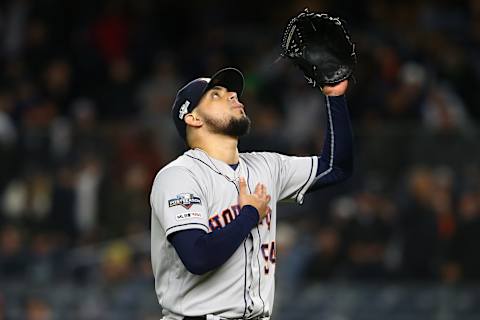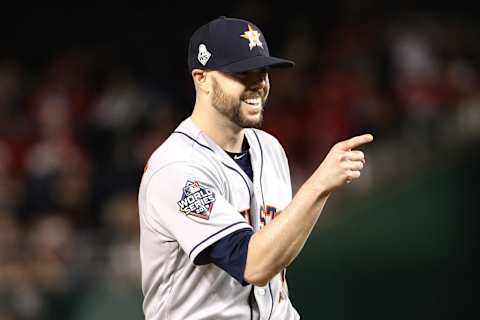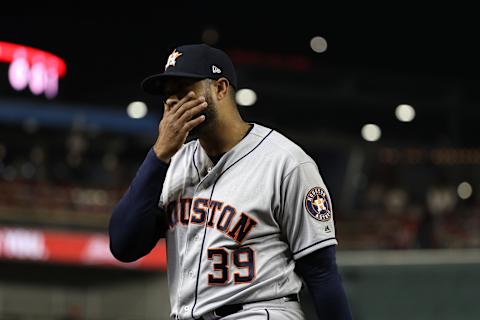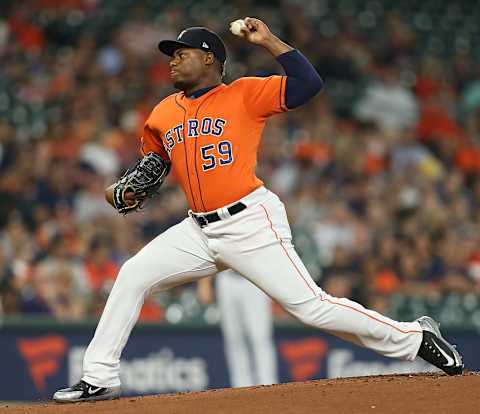Astros Report Card: Grading the 2019 relief pitchers; Part II


The Astros had one of the top bullpens last season, so let’s dive right into Part II of the 2019 relief pitcher’s Report Card in this Report Card 5th installment.
Roberto Osuna: A+
The Astros‘ primary closer, Roberto Osuna, was having a successful year on the mound in his first full season in Houston. His past troubles and controversies that surrounded him seemed to be behind him. Then in a postseason celebration, assistant GM Brandon Taubman made an apparent inappropriate statement about the acquisition of Osuna that resulted in Taubman getting fired and it all resurfaced.
But we can’t let that overshadow the outstanding campaign that he had in 2019 and hopefully, by the beginning of next season it will all be behind him, and he can continue closing out games as he did this season.
Osuna had a start to the season that many pitchers don’t experience. In the first 22 games, he surrendered just two runs and issued only two walks in his 22.1 innings of work. In that time frame, he had a record of 2-0, a 0.81 ERA, and accumulated 13 saves in 13 opportunities, not one blown save.
In the next two games, he showed that he was human and gave up two earned runs in each appearance and got his first blown save of the year. But he went on to have a very productive season and one of the best in his five-year career.
Osuna ended the season with 2.63 ERA and led the American League with 38 saves. He had the most finished games (56) in the entire Major League. His 0.877 WHIP was the lowest in his career and good for fourth-best among fangraphs.com qualified pitchers in the American League.
He is in the final season of his contract with the Astros and will be in an arbitration year in 2020. Houston does have control over him through the 2021 season and then he’ll be eligible for free agency in 2022.

Ryan Pressly: B+
Here is another pitcher, like Osuna, that had a historic start to the 2019 season. Pressly didn’t surrender his first run of the season until May 24th, his 20th appearance of the year. In fact, dating back to the previous season, Pressly went 40 straight games without giving up one single run. That set a Major League record beating out Craig Kimbrel who held the record with 38.
Pressly had a spectacular first half of the season carrying an ERA of 0.81 in his first 32 games of the year. He had already collected 19 of his 31 holds on the season. Those 31 holds were tied for the most in the Major Leagues and the most in his 12-year career.
His 0.90 WHIP ranked the fifth lowest for AL relievers, one spot below Osuna, and was the second-best on the team among relievers with 10 innings or more of work. He ended the season with an ERA of 2.32 the 10th lowest in the league. Both of those stats were the best of his career.
Pressly had the second-highest SO/9IP (11.93) and SO/BB (6.00) and second-best BB/9IP ratios out of all Houston relievers, again with at least 10 innings under their belt.
In March of this year, the Astros and Pressly agreed to a two-year extension to his contract that will keep him in Houston through the 2021 season with a club option in 2022. So the one-two punch of Pressly/Osuna will be around for a couple of more years.

Josh James: C-
In his first full season with the Astros, Josh James was a bit disappointing. Although he missed the entire month of August due to shoulder soreness, James got in 48 appearances and 60.1 innings of relief on the books. He ended the season 5-1 with six holds and was only able to get one save out of his three save opportunities.
In those 48 games out of the bullpen, he had an ERA of 4.77 and a 1.34 WHIP, both the second-highest among Astros relief pitchers with 25 innings or more of work. The flame thrower did, however, lead the bullpen with 99 strikeouts and a 14.77 SO/9IP.
The 26-year-old’s issue, for the most part, was his control. James had one of the teams higher BB/9IP ratio with a 5.22. That took away from his high strikeout count taking his K/BB ratio down to 2.83, which is pretty low for a pitcher with a SO/9IP he had. It also showed up in the number of pitches it took James to get through an inning, as he carried an 18.63 pitch/inning count.
The potential can be seen with James and I still believe he has a bright future with the Astros. He did have injury issues during Spring Training and got in very little work prior to the season, plus his late-season shoulder issues plaguing him. I look forward to seeing how he does in 2020.

Framber Valdez: D+
Valdez is another rookie pitcher that didn’t have the breakout season everyone had hoped for. After the success he had in the late-season call-up in 2018, the expectations were very high for Valdez.
He appeared in 18 games in relief for a total of 35 innings. In those games out of the pen, Valdez had the highest WHIP of 1.63 and the third-highest ERA of 4.63 among the relievers with at least 25 innings.
Like James, Valdez had trouble getting his pitches over the plate. He carried one of the highest BB/9IP (5.40) along with a very low K/BB (1.38). But on top of those numbers, he was also allowing opponents to have a fairly high batting average of .265. When you combine all of those, you’re not going to have great results.
I will give him credit though, it had to make things more difficult for him with the inconsistent way he was utilized. He bounced back and forth between Houston and Round Rock three times during the season. Valdez was also thrust into a starting position quite a bit in the second half of the season due to injuries in the starting rotation. The results were disastrous and had to shake up his confidence somewhat.
Hopefully, Valdez can get in some useful work this winter and Spring Training and turn things around for 2020. Depending on how things shake out this offseason, the Astros may need to rely on him again in 2020.
Next. With the Astros already assumed guilty of cheating, what will be the results?. dark
There were quite a few other pitchers that played roles in the bullpen in 2019, but for the sake of this article, I only handed out grades to the relievers that had a minimum of 25 innings of work out of the pen. I’d also like to remind you, in case you have missed them, report cards have been issued on the starting pitchers, infielders, and outfielders, as well as the five other relievers. Be sure not to miss them.